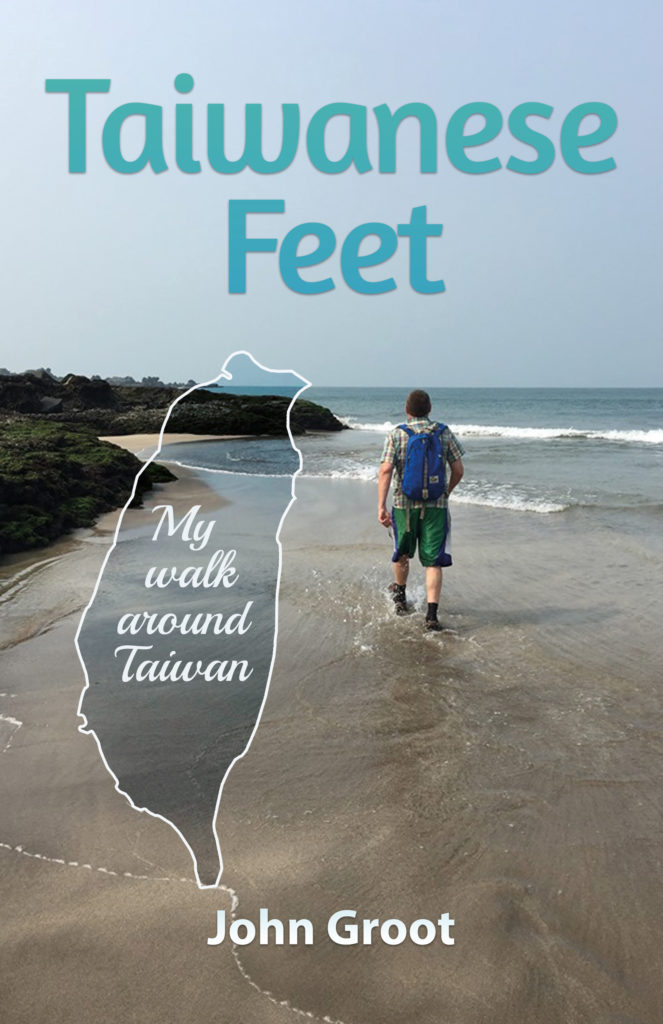…………
John Groot is the author of Taiwanese Feet: My Walk Around Taiwan. Originally from Canada, since 2001 he has lived in Taiwan. To supplement his travel writing, he teaches English and international communication skills to computer industry workers. From his adopted hometown of Tamsui, New Taipei City, where he lives with his wife, Groot has traveled extensively in Asia and literally all around Taiwan. Between 2006 and 2014 over a total of 83 walking days, he hiked clockwise around the coastline of Taiwan.
*
What was the inspiration for the trip? Well, for me that seems as obvious as looking at a map, so I’ll reword my question; how did the trip go from the daydream stage of “It would be pretty cool to circumnavigate Taiwan on foot,” to you actually making up your mind to do it and setting off?
It was kind of an intuitive thing, like a slowly growing impulse that took about 6 months to fully take hold of me. But in the end the key factor was that it seemed pretty logistically doable. There was just no big reason NOT to do it.

I understand you’re a keen Hash Harrier. Did this help get you in shape for the walking (and drinking) on your walk?
It didn’t hurt! But the Hash is much hillier and boozier than my walk. And a LOT noisier!
Your method of walking the coastline in stages rather than one or several long walks meant an awful lot of time and moment spent on public transport. Anything learnt from all those miles clocked up?
Yeah, some of those commutes were time-consuming and dull. But coming from Canada, a huge country with massive travel times and distance, it was great that I could get from Taipei to the southern tip of Taiwan in five hours, affordably.
What shoes did you wear for your walk? Any footwear recommendations for long-distance walking, and in particular for scrambling around the coastline?
Merrell shoes always seemed the best to me. They had good nobbly treads, were pretty light and strong, and held up under abuse. I mean, Nikes would have been destroyed in a couple of days on some sections of the coast.
Are there any pieces of equipment – say a trusty old hat, Swiss Army knife, or backpack – that you developed a fondness for during the walk?
All of the above, but none of them lasted the whole eight years. However, I did really like it if I could find a good walking stick, usually bamboo from a farm or a piece of driftwood from the beach. Then I would stash it at the end of one journey, and pick it up and use it again next time I came down. That always made me feel good.
Quite a lot of your walk was done in the high temps and humidity of summer. How did you handle the heat?
Hydration, hydration, hydration. And also you have to know your limits. I’d pushed myself into severe heat exhaustion several times when I was younger, so I knew how fast your system can go kaput if you cross the line. Just do what the farmers here do: the hotter it gets, the slower you move.
What maps did you use to plan out your route and to navigate your way once on the ground?
I went through quite a few maps at first. But actually the paper maps I could get weren’t that much use when I was walking. I usually just used Google Earth before the walk, and also maybe afterward to see what I’d done. Later on when I had a proper cell phone, I used Google Maps when I was walking as well.
Did you use any travel guides for your walk?
No, I didn’t really need to. But I’ve always been a Lonely Planet fan, probably due to my happy reliance on it in during my six months in India.
One of the encouraging takeaways from Ian Easton’s excellent The Chinese Invasion Threat is that there are relatively few coastal sites which are suitable for the ChiComs to land on. Did your walk around Taiwan make you more optimistic or pessimistic about the physical challenges the PLA would face should they try to land troops and equipment on the island?
Interesting question. But thinking about it in simple physical terms could be a bit misleading. Yeah, there are a limited selection of landing spots. They could be overrun. They could also be mass graveyards for patriotic young PLA soldiers if the ROC army does it right. It would all depend on the will to defend Taiwan. If the Taiwanese never surrender, the Chinese can never win. The natural castle that is Taiwan gives the defenders a huge advantage. But they’d have to be willing to die for it. And kill a LOT of PLA soldiers.
Most of your walk was done solo, but sometimes a friend tagged along. Can you tell us about a few of them?
The walk to Jinshan with Taiwanese Jerry and Noel the Aussie was good fun, especially suddenly arriving at the lively night market in Jinbaoli Old Street after walking through moonlit farmland. And the walks into Keelung and Hualien with Texas Don were also fine little adventures with lots of jokes and chatting along the way. Those were all good times!
Did you encounter any other long-distance walkers on your travels around the coastline?
No other walkers, no, but hundreds of bikers. And lots of other oddball travelers, bussing or driving around on their own solo adventures.
You look set to be a Taiwan lifer. Come retirement, if you decided to leave Taipei for somewhere quieter and cheaper, where would you like to settle? Do you hear the many and varied charms of coastal Yunlin calling you?
As charming as Yunlin is with its flat muddy coastline and farmyard aromas, I think I would be more of an East Coaster. Maybe somewhere in Yilan like Su’ao, within a 90-minute trip to Taipei, but in the clean and green. I’d like to see a few more sunrises from out of the ocean. There’s nothing quite like it. It’s a more optimistic feeling than sunsets as one gets older.
What are some of your favorite travel books?
Well, there are so many great authors and stories. Of course I love Bill Bryson and Paul Theroux. Some books from lesser known authors that influenced me were Jupiter’s Travels by Ted Simon, about his epic motorcycle trip around the world from 1973 to 1977; Mad White Gantry Benedict Allen, a 1985 account of his journey on foot from the Orinoco to the Amazon river; Paddle to the Amazonby Don Starkell, the true story of Don and his son Dana’s two-year, 19,603km journey by canoe from Winnipeg, Canada to Belem, Brazil. And last but not least, probably the best-written and most compelling of all these books, Shadows on the Wastelandby Mike Stroud. It describes how Stroud, a medical doctor and exercise enthusiast accompanies explorer Ranulph Fiennes as they made the first unsupported crossing of the Antarctic continent from 1992-93. Sitting back in the comfort of my armchair and reading about the intensity of their efforts was really exciting. But the common thread in all of these books was the sense of mad adventure!
What was the hardest thing about writing Taiwanese Feet?
I guess the hardest thing was just getting it done. Writing a book is a lot like climbing a mountain: it gets tougher and tougher as you get closer to completion. But I just used the same strategy I used for completing the walk. Just keep going!
What projects are you working on at the moment?
Well, I have my Facebook fan page Walkaboot (Taipei) where I do some photo-blogging, my article blog The Culture Shack, and I want to gradually do more on YouTube. But the next main thing HAS to be another book. I am mulling a couple of options now, and I’ll let you know when I decide.
I’m sure your Taiwanese Feet will inspire many people to pursue their own travel dreams. Any words of advice for those looking to accomplish a long-distance walking adventure?
Go for it! Do your homework first, and make all necessary preparations. But once you start, just keep putting one food in front of another until you get where you’re going. It’s easy to lose motivation, but never give up.
Taiwanese Feet is published by Clear Sky Communications. It’s available from Amazon as an ebook or a paperback. In Taiwan the paperback (with color photographs, as opposed to the black and white ones in the Print on Demand edition on Amazon) is also available directly from the author. See the Taiwanese Feet Facebook page or contact the author at taiwanese.feet@gmail.com.
